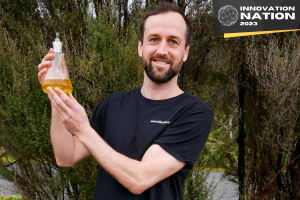
A comparison between New Zealand and Australia’s approach to biotech shows we’re doing a lot of things right, but that government support for the sector in New Zealand could be improved. New Zealand biotech leaders say that if a comprehensive government biotech strategy isn’t prioritised soon, the sector will continue to fall behind in many areas.
“Both countries have exceptional researchers and huge potential to be leaders in biotech. However, the research landscape in Australia is backed with far more government funding and resourcing,” says John Robson, General Manager of Bridgewest Ventures New Zealand.
“We have a unique opportunity to learn from the successes of Australia, and to seek to influence policy at this important time as the new government pursues input from industry and examples of successful models.
“New Zealand needs to invest more into the biotech research landscape to maximise innovation, and time is of the essence,” Robson says.
A 2020 New Zealand Biotechnology Sector Survey by BioTechNZ identified that access to capital was considered, by far, the most significant constraint for both research and commercialisation activities.
“Not only does Australia provide higher investment capital into research and commercialisation, it also does very well at marketing itself as a place to innovate. So it’s not that we don’t have a good offering, but that Australia is better at communicating the benefits of conducting research there, and the associated tax benefits available, and this has gained them better visibility globally,” says Robson.
Robson points to the recently published AusBiotech Biotechnology Blueprint which provides an outline of the next 10 years for the Australian Biotechnology Industry. Access to capital to support commercialisation and clinical development is a key factor in the growth of the sector, and this is included along with eight core, critical areas of focus. These strategic recommendations, says Robson, are identical to the issues in New Zealand and we should seek to follow their lead starting with a greater focus on public private partnerships, and building out sovereign capabilities with investment in new infrastructure.

Julie Jones, CEO of clinical research organisation BioValeo, says that Australia has widely publicised their R&D tax incentive to generate extensive interest and growth within the clinical research space. New Zealand provides a similar tax incentive that offers a significant opportunity for sector growth if leveraged and publicised effectively.
Jones is keen to see the development of easily accessible and user-friendly information for those wishing to conduct clinical trials in New Zealand. Australia’s Clinical Trial Handbook provides guidance on the legislative, regulatory and good clinical practice requirements (GCP) when conducting trials. New Zealand could benefit from a similar, single guidance document that provides comprehensive information related to national clinical research requirements.
Template documents, such as the national contract templates provided by the New Zealand Association of Clinical research (NZACRes) and the template participant information and consent forms, provided on the Health and Disability Ethics Committees (HDEC) website, support streamlined processes that offer efficiency and quality.
“NZ has the opportunity to boost its great clinical trial infrastructure by investing into the research landscape. The single health authority, Health New Zealand – Te Whatu Ora, should enable the industry to provide more equitable access to clinical trials and support the New Zealand clinical research ecosystem,” she adds.
Dr Zahra Champion, Executive Director of BioTechNZ, also says we need to be doing more to showcase New Zealand’s capability and that the Government should increase support to the biotech sector to create a scalable, thriving and vibrant ecosystem that will attract global attention.
“NZ also has a rich history in agriculture, human and animal health, however, Australia earned themselves a solid reputation internationally, by creating long-term strategies and roadmaps”, says Champion.
But it’s not to say good things aren’t already happening, Robson notes. There are a number of strategic alliances providing positive outcomes for the sector, including one between Huadu International Group, a specialist real estate development company based in Christchurch, and Bridgewest Ventures.

“Our agreement is to co-develop a multi-disciplinary cancer treatment, health technology and research and innovation centre in Christchurch – with scope to expand into other regions. It’s part of a multi-year plan to support the local economy and to also reinforce Huadu’s prior investments into the Te Papa Hauora Health Precinct, explains Robson.
In Australia, the Bridgewest Group recently recognised an opportunity to acquire a new sterile injectable manufacturing plant, launching NovaCina as a Contract Development and Manufacturing Organisation (CDMO) in Perth, WA. The City of Perth has a dynamic and rapidly growing health and medical life sciences sector, and Australia’s life sciences sector is one of the largest in the southern hemisphere, estimated at more than A$250 billion.
“This is a significant example of the kind of collaborations New Zealand could be involved with, to drive growth in the sector. Which is why we’re advocating for more initiatives to foster such partnerships within New Zealand’s ecosystem,” says Robson.
With a 10-year health research strategy still being worked through, it’s alarming to both Robson and Champion that to-date a biotech-specific government strategy paper is missing; however, it is promising with the new coalition government, and with the National Party policy document titled Harnessing Biotech published last year.
“Australia has a very specific biotech strategy, with firm goals of what investment should go into each area and what the action plan looks like for the future whereas ours is only part of the wider health ministry strategy. This means for overseas investors, it’s very easy to understand the Australian market, compared to New Zealand.
For those in the biotech sector, they see ‘strategic connectedness’ as a critical element of moving forward, with a recommendation to improve our visibility and raise the profile of biotech in New Zealand.
“Some of the pressure points for the New Zealand Government, include enhanced funding, lack of infrastructure and training, retaining and attracting talent, which we can learn from Australia’s intensive capital government investments in the biotech sector,” says Champion.
“We know Australia has wider capabilities for, and more options of service providers. But raising the profile of biotechnology in New Zealand is crucial. There is clear evidence from the technology sector that tracking and reporting on the successes of the top firms creates momentum, helps those in the relevant industries to coordinate with the Government, and also attracts international capital.
“There’s so much potential there, so it’s imperative to invest into it,” she says.
Story by Erin Harrison








